Portable Sensors for Dynamic Exposure Assessments in Urban Environments: State of the Science
Abstract
:1. Introduction
2. Materials and Methods
2.1. Sensor System Selection
- commercially available
- wireless/power solution (battery or via car)
- weatherproof housing
- data transmission/logging solution (internal, USB, Bluetooth, LTE-M, LoRA, wifi)
- sensor capability to monitor PM, NO2, and/or BC
- availability of particle mass concentration (µg/m3; instead of particle number concentration)
- power autonomy (battery instead of car-powered systems)
- GPS localization (internal or via smartphone)
2.2. Benchmarking Protocol
2.2.1. Laboratory Test Protocol
- Lack-of-fit (linearity) at setpoints 0, 30, 40, 60, 130, 200, and 350 µg/m3 (PM10, dolomite dust). This concentration range can be considered representative for exhibited PM levels in typical urban environments [2,36,37,38,39,40,41,42]. A Palas Particle dispenser (RBG 100) system connected to a fan-based dilution system and aluminum PM exposure chamber was used.
- Sensitivity of PM sensor to the coarse (2.5–10 µm) particle fraction. We dosed, sequentially, 7.750 µm and 1.180 µm-sized monodisperse dust (silica nanospheres with density of 2 g/cm3) using an aerosolizer (from the Grimm 7.851 aerosol generator) system connected to a fan-based dilution system and an aluminum PM exposure chamber with fans to have homogeneous PM concentrations. This testing protocol is currently considered to be included in the CEN/TS 17660-2 (in preparation) on performance targets for PM sensors.
- Lack-of-fit (linearity) at setpoints of 0, 40, 100, 140, and 200 μg/m3.
- Sensor sensitivity to relative humidity at 15, 50, 70, and 90% (±5%) during stable temperature conditions of 20 ± 1 °C.
- Sensor sensitivity to temperature at −5, 10, 20, and 30 °C (±3 °C) during stable relative humidity conditions of 50 ± 5%.
- Sensor cross-sensitivity to ozone (120 µg/m3) at zero and 100 µg/m3.
- Sensor response time under rapidly changing NO2 concentrations (from 0 to 200 µg/m3).
2.2.2. Mobile Field Test
2.2.3. Field Co-Location Campaign
- Hourly data coverage (%)
- Timeseries plot: RAW & LAB CAL
- Scatter plot: RAW & LAB CAL
- Comparability between sensors: between-sensor uncertainty (BSU)
- Comparability with reference (hourly): R2, RMSE, MAE, MBE
- Expanded uncertainty (non-parametric): Uexp (%)
3. Results
3.1. Laboratory Test
3.1.1. PM
- Relative change (%) in fractional (coarse vs. fine) sensor/REF ratio during respective fine and coarse test conditions:
- Relative change (%) in PM10 sensor/REF ratio between fine and coarse test conditions:
3.1.2. NO2
3.2. Mobile Field Test
3.3. Field Co-Location Campaign
4. Discussion
5. Conclusions
Supplementary Materials
Author Contributions
Funding
Institutional Review Board Statement
Informed Consent Statement
Data Availability Statement
Conflicts of Interest
References
- EEA. Harm to human health from air pollution in Europe: Burden of disease 2023. ETC HE Rep. 2023, 7, 104. [Google Scholar]
- Morales Betancourt, R.; Galvis, B.; Balachandran, S.; Ramos-Bonilla, J.P.; Sarmiento, O.L.; Gallo-Murcia, S.M.; Contreras, Y. Exposure to fine particulate, black carbon, and particle number concentration in transportation microenvironments. Atmos. Environ. 2017, 157, 135–145. [Google Scholar] [CrossRef]
- Knibbs, L.D.; Cole-Hunter, T.; Morawska, L. A review of commuter exposure to ultrafine particles and its health effects. Atmos. Environ. 2011, 45, 2611–2622. [Google Scholar] [CrossRef]
- Vandeninden, B.; Vanpoucke, C.; Peeters, O.; Hofman, J.; Stroobants, C.; De Craemer, S.; Hooyberghs, H.; Dons, E.; Van Poppel, M.; Panis, L.I.; et al. Uncovering Spatio-temporal Air Pollution Exposure Patterns During Commutes to Create an Open-Data Endpoint for Routing Purposes. In Hidden Geographies; Krevs, M., Ed.; Springer International Publishing: Cham, Germany, 2021; pp. 115–151. [Google Scholar]
- Moreno, T.; Reche, C.; Rivas, I.; Cruz Minguillón, M.; Martins, V.; Vargas, C.; Buonanno, G.; Parga, J.; Pandolfi, M.; Brines, M.; et al. Urban air quality comparison for bus, tram, subway and pedestrian commutes in Barcelona. Environ. Res. 2015, 142, 495–510. [Google Scholar] [CrossRef]
- de Nazelle, A.; Fruin, S.; Westerdahl, D.; Martinez, D.; Ripoll, A.; Kubesch, N.; Nieuwenhuijsen, M. A travel mode comparison of commuters’ exposures to air pollutants in Barcelona. Atmos. Environ. 2012, 59, 151–159. [Google Scholar] [CrossRef]
- Beckx, C.; Int Panis, L.; Uljee, I.; Arentze, T.; Janssens, D.; Wets, G. Disaggregation of nation-wide dynamic population exposure estimates in The Netherlands: Applications of activity-based transport models. Atmos. Environ. 2009, 43, 5454–5462. [Google Scholar] [CrossRef]
- Fruin, S.A.; Winer, A.M.; Rodes, C.E. Black carbon concentrations in California vehicles and estimation of in-vehicle diesel exhaust particulate matter exposures. Atmos. Environ. 2004, 38, 4123–4133. [Google Scholar] [CrossRef]
- Dons, E.; Int Panis, L.; Van Poppel, M.; Theunis, J.; Wets, G. Personal exposure to Black Carbon in transport microenvironments. Atmos. Environ. 2012, 55, 392–398. [Google Scholar] [CrossRef]
- Dons, E.; De Craemer, S.; Huyse, H.; Vercauteren, J.; Roet, D.; Fierens, F.; Lefebvre, W.; Stroobants, C.; Meysman, F. Measuring and modelling exposure to air pollution with citizen science: The CurieuzeNeuzen project. In Proceedings of the ISEE 2020 Virtual Conference: 32nd Annual Conference of the International Society of Environmental Epidemiology, Virtual, 24 August 2020; ISEE Conference Abstracts. Volume 2020. [Google Scholar] [CrossRef]
- Hofman, J.; Peters, J.; Stroobants, C.; Elst, E.; Baeyens, B.; Laer, J.V.; Spruyt, M.; Essche, W.V.; Delbare, E.; Roels, B.; et al. Air Quality Sensor Networks for Evidence-Based Policy Making: Best Practices for Actionable Insights. Atmosphere 2022, 13, 944. [Google Scholar] [CrossRef]
- Van Poppel, M.; Hoek, G.; Viana, M.; Hofman, J.; Theunis, J.; Peters, J.; Kerckhoffs, J.; Moreno, T.; Rivas, I.; Basagaña, X.; et al. Deliverable D13 (D2.5): Description of Methodology for Mobile Monitoring and Citizen Involvement; RI-URBANS Project Deliverable D2.5. 2022. Available online: https://riurbans.eu/wp-content/uploads/2022/10/RI-URBANS_D13_D2.5.pdf (accessed on 15 May 2024).
- Wesseling, J.; Hendricx, W.; de Ruiter, H.; van Ratingen, S.; Drukker, D.; Huitema, M.; Schouwenaar, C.; Janssen, G.; van Aken, S.; Smeenk, J.W.; et al. Assessment of PM2.5 Exposure during Cycle Trips in The Netherlands Using Low-Cost Sensors. Int. J. Environ. Res. Public Health 2021, 18, 6007. [Google Scholar] [CrossRef]
- Carreras, H.; Ehrnsperger, L.; Klemm, O.; Paas, B. Cyclists’ exposure to air pollution: In situ evaluation with a cargo bike platform. Environ. Monit. Assess. 2020, 192, 470. [Google Scholar] [CrossRef] [PubMed]
- Hofman, J.; Samson, R.; Joosen, S.; Blust, R.; Lenaerts, S. Cyclist exposure to black carbon, ultrafine particles and heavy metals: An experimental study along two commuting routes near Antwerp, Belgium. Environ. Res. 2018, 164, 530–538. [Google Scholar] [CrossRef] [PubMed]
- Dons, E.; Laeremans, M.; Orjuela, J.P.; Avila-Palencia, I.; Carrasco-Turigas, G.; Cole-Hunter, T.; Anaya-Boig, E.; Standaert, A.; De Boever, P.; Nawrot, T.; et al. Wearable Sensors for Personal Monitoring and Estimation of Inhaled Traffic-Related Air Pollution: Evaluation of Methods. Environ. Sci. Technol. 2017, 51, 1859–1867. [Google Scholar] [CrossRef] [PubMed]
- Blanco, M.N.; Bi, J.; Austin, E.; Larson, T.V.; Marshall, J.D.; Sheppard, L. Impact of Mobile Monitoring Network Design on Air Pollution Exposure Assessment Models. Environ. Sci. Technol. 2023, 57, 440–450. [Google Scholar] [CrossRef] [PubMed]
- Fu, X.; Cai, Q.; Yang, Y.; Xu, Y.; Zhao, F.; Yang, J.; Qiao, L.; Yao, L.; Li, W. Application of Mobile Monitoring to Study Characteristics of Air Pollution in Typical Areas of the Yangtze River Delta Eco-Green Integration Demonstration Zone, China. Sustainability 2023, 15, 205. [Google Scholar] [CrossRef]
- Hofman, J.; Do, T.H.; Qin, X.; Bonet, E.R.; Philips, W.; Deligiannis, N.; La Manna, V.P. Spatiotemporal air quality inference of low-cost sensor data: Evidence from multiple sensor testbeds. Environ. Model. Softw. 2022, 149, 105306. [Google Scholar] [CrossRef]
- Chen, Y.; Gu, P.; Schulte, N.; Zhou, X.; Mara, S.; Croes, B.E.; Herner, J.D.; Vijayan, A. A new mobile monitoring approach to characterize community-scale air pollution patterns and identify local high pollution zones. Atmos. Environ. 2022, 272, 118936. [Google Scholar] [CrossRef]
- Messier, K.P.; Chambliss, S.E.; Gani, S.; Alvarez, R.; Brauer, M.; Choi, J.J.; Hamburg, S.P.; Kerckhoffs, J.; LaFranchi, B.; Lunden, M.M.; et al. Mapping Air Pollution with Google Street View Cars: Efficient Approaches with Mobile Monitoring and Land Use Regression. Environ. Sci. Technol. 2018, 52, 12563–12572. [Google Scholar] [CrossRef]
- Van den Bossche, J. Towards High Spatial Resolution Air Quality Mapping: A Methodology to Assess Street-Level Exposure Based on Mobile Monitoring. Ph.D. Thesis, Ghent University, Ghent, Belgium, 2016. [Google Scholar]
- Helbig, C.; Ueberham, M.; Becker, A.M.; Marquart, H.; Schlink, U. Wearable Sensors for Human Environmental Exposure in Urban Settings. Curr. Pollut. Rep. 2021, 7, 417–433. [Google Scholar] [CrossRef]
- Kang, Y.; Aye, L.; Ngo, T.D.; Zhou, J. Performance evaluation of low-cost air quality sensors: A review. Sci. Total Environ. 2022, 818, 151769. [Google Scholar] [CrossRef]
- Karagulian, F.; Barbiere, M.; Kotsev, A.; Spinelle, L.; Gerboles, M.; Lagler, F.; Redon, N.; Crunaire, S.; Borowiak, A. Review of the Performance of Low-Cost Sensors for Air Quality Monitoring. Atmosphere 2019, 10, 506. [Google Scholar] [CrossRef]
- Peters, J.; Van Poppel, M. Literatuurstudie, Marktonderzoek en Multicriteria-Analyse Betreffende Luchtkwaliteitssensoren en Sensorboxen; VITO: Mol, Belgium, 2020. [Google Scholar]
- Park, Y.M.; Sousan, S.; Streuber, D.; Zhao, K. GeoAir-A Novel Portable, GPS-Enabled, Low-Cost Air-Pollution Sensor: Design Strategies to Facilitate Citizen Science Research and Geospatial Assessments of Personal Exposure. Sensors 2021, 21, 3761. [Google Scholar] [CrossRef]
- Varaden, D.; Leidland, E.; Lim, S.; Barratt, B. “I am an air quality scientist”—Using citizen science to characterise school children’s exposure to air pollution. Environ. Res. 2021, 201, 111536. [Google Scholar] [CrossRef] [PubMed]
- Wesseling, J.; de Ruiter, H.; Blokhuis, C.; Drukker, D.; Weijers, E.; Volten, H.; Vonk, J.; Gast, L.; Voogt, M.; Zandveld, P.; et al. Development and implementation of a platform for public information on air quality, sensor measurements, and citizen science. Atmosphere 2019, 10, 445. [Google Scholar] [CrossRef]
- Lim, C.C.; Kim, H.; Vilcassim, M.J.R.; Thurston, G.D.; Gordon, T.; Chen, L.-C.; Lee, K.; Heimbinder, M.; Kim, S.-Y. Mapping urban air quality using mobile sampling with low-cost sensors and machine learning in Seoul, South Korea. Environ. Int. 2019, 131, 105022. [Google Scholar] [CrossRef]
- Volten, H.; Devilee, J.; Apituley, A.; Carton, L.; Grothe, M.; Keller, C.; Kresin, F.; Land-Zandstra, A.; Noordijk, E.; van Putten, E.; et al. Enhancing national environmental monitoring through local citizen science. In Citizen Science; Hecker, S., Haklay, M., Bowser, A., Makuch, Z., Vogel, J., Bonn, A., Eds.; UCL Press: London, UK, 2018; pp. 337–352. [Google Scholar]
- Fishbain, B.; Lerner, U.; Castell, N.; Cole-Hunter, T.; Popoola, O.; Broday, D.M.; Iñiguez, T.M.; Nieuwenhuijsen, M.; Jovasevic-Stojanovic, M.; Topalovic, D.; et al. An evaluation tool kit of air quality micro-sensing units. Sci. Total Environ. 2016, 575, 639–648. [Google Scholar] [CrossRef]
- Jiang, Q.; Kresin, F.; Bregt, A.K.; Kooistra, L.; Pareschi, E.; van Putten, E.; Volten, H.; Wesseling, J. Citizen Sensing for Improved Urban Environmental Monitoring. J. Sens. 2016, 2016, 5656245. [Google Scholar] [CrossRef]
- Molina Rueda, E.; Carter, E.; L’Orange, C.; Quinn, C.; Volckens, J. Size-Resolved Field Performance of Low-Cost Sensors for Particulate Matter Air Pollution. Environ. Sci. Technol. Lett. 2023, 10, 247–253. [Google Scholar] [CrossRef]
- Kuula, J.; Mäkelä, T.; Aurela, M.; Teinilä, K.; Varjonen, S.; Gonzales, O.; Timonen, H. Laboratory evaluation of particle size-selectivity of optical low-cost particulate matter sensors. Atmos. Meas. Tech. 2020, 13, 2413–2423. [Google Scholar] [CrossRef]
- Languille, B.; Gros, V.; Nicolas, B.; Honoré, C.; Kaufmann, A.; Zeitouni, K. Personal Exposure to Black Carbon, Particulate Matter and Nitrogen Dioxide in the Paris Region Measured by Portable Sensors Worn by Volunteers. Toxics 2022, 10, 33. [Google Scholar] [CrossRef]
- Lauriks, T.; Longo, R.; Baetens, D.; Derudi, M.; Parente, A.; Bellemans, A.; van Beeck, J.; Denys, S. Application of Improved CFD Modeling for Prediction and Mitigation of Traffic-Related Air Pollution Hotspots in a Realistic Urban Street. Atmos. Environ. 2021, 246, 118127. [Google Scholar] [CrossRef]
- Zeb, B.; Alam, K.; Sorooshian, A.; Blaschke, T.; Ahmad, I.; Shahid, I. On the morphology and composition of particulate matter in an urban environment. Aerosol Air Qual. Res. 2018, 18, 1431–1447. [Google Scholar] [CrossRef]
- Kumar, P.; Patton, A.P.; Durant, J.L.; Frey, H.C. A review of factors impacting exposure to PM2.5, ultrafine particles and black carbon in Asian transport microenvironments. Atmos. Environ. 2018, 187, 301–316. [Google Scholar] [CrossRef]
- Peters, J.; Theunis, J.; Poppel, M.V.; Berghmans, P. Monitoring PM10 and Ultrafine Particles in Urban Environments Using Mobile Measurements. Aerosol Air Qual. Res. 2013, 13, 509–522. [Google Scholar] [CrossRef]
- Pirjola, L.; Lähde, T.; Niemi, J.V.; Kousa, A.; Rönkkö, T.; Karjalainen, P.; Keskinen, J.; Frey, A.; Hillamo, R. Spatial and temporal characterization of traffic emissions in urban microenvironments with a mobile laboratory. Atmos. Environ. 2012, 63, 156–167. [Google Scholar] [CrossRef]
- Kaur, S.; Nieuwenhuijsen, M.J.; Colvile, R.N. Fine particulate matter and carbon monoxide exposure concentrations in urban street transport microenvironments. Atmos. Environ. 2007, 41, 4781–4810. [Google Scholar] [CrossRef]
- Vercauteren, J. Performance Evaluation of Six Low-Cost Particulate Matter Sensors in the Field; VAQUUMS: VMM: Antwerp, Belgium, 2021. [Google Scholar]
- Weijers, E.; Vercauteren, J.; van Dinther, D. Performance Evaluation of Low-Cost Air Quality Sensors in the Laboratory and in the Field; VAQUUMS: VMM: Antwerp, Belgium, 2021. [Google Scholar]
- CEN: CEN/TS 17660-1:2022; Air Quality—Performance Evaluation of Air Quality Sensor Systems—Part 1: Gaseous Pollutants in Ambient Air. CEN: Brussels, Belgium, 2022.
- Ma, L.; Zhang, C.; Wang, Y.; Peng, G.; Chen, C.; Zhao, J.; Wang, J. Estimating Urban Road GPS Environment Friendliness with Bus Trajectories: A City-Scale Approach. Sensors 2020, 20, 1580. [Google Scholar] [CrossRef] [PubMed]
- Merry, K.; Bettinger, P. Smartphone GPS accuracy study in an urban environment. PLoS ONE 2019, 14, e0219890. [Google Scholar] [CrossRef] [PubMed]
- Hofman, J.; Nikolaou, M.; Shantharam, S.P.; Stroobants, C.; Weijs, S.; La Manna, V.P. Distant calibration of low-cost PM and NO2 sensors; evidence from multiple sensor testbeds. Atmos. Pollut. Res. 2022, 13, 101246. [Google Scholar] [CrossRef]
- Mijling, B.; Jiang, Q.; de Jonge, D.; Bocconi, S. Field calibration of electrochemical NO2 sensors in a citizen science context. Atmos. Meas. Tech. 2018, 11, 1297–1312. [Google Scholar] [CrossRef]
- Karagulian, F.; Borowiak, W.; Barbiere, M.; Kotsev, A.; Van den Broecke, J.; Vonk, J.; Signironi, M.; Gerboles, M. Calibration of AirSensEUR Boxes during a Field Study in the Netherlands; European Commission: Ispra, Italy, 2020. [Google Scholar]
- Tagle, M.; Rojas, F.; Reyes, F.; Vásquez, Y.; Hallgren, F.; Lindén, J.; Kolev, D.; Watne, Å.K.; Oyola, P. Field performance of a low-cost sensor in the monitoring of particulate matter in Santiago, Chile. Environ. Monit. Assess. 2020, 192, 171. [Google Scholar] [CrossRef]
- Crilley, L.R.; Singh, A.; Kramer, L.J.; Shaw, M.D.; Alam, M.S.; Apte, J.S.; Bloss, W.J.; Hildebrandt Ruiz, L.; Fu, P.; Fu, W.; et al. Effect of aerosol composition on the performance of low-cost optical particle counter correction factors. Atmos. Meas. Tech. 2020, 13, 1181–1193. [Google Scholar] [CrossRef]
- Badura, M.; Batog, P.; Drzeniecka-Osiadacz, A.; Modzel, P. Evaluation of Low-Cost Sensors for Ambient PM2.5 Monitoring. J. Sens. 2018, 2018, 5096540. [Google Scholar] [CrossRef]
- Di Antonio, A.; Popoola, O.A.M.; Ouyang, B.; Saffell, J.; Jones, R.L. Developing a Relative Humidity Correction for Low-Cost Sensors Measuring Ambient Particulate Matter. Sensors 2018, 18, 2790. [Google Scholar] [CrossRef] [PubMed]
- Feenstra, B.; Papapostolou, V.; Hasheminassab, S.; Zhang, H.; Boghossian, B.D.; Cocker, D.; Polidori, A. Performance evaluation of twelve low-cost PM2.5 sensors at an ambient air monitoring site. Atmos. Environ. 2019, 216, 116946. [Google Scholar] [CrossRef]
- Jayaratne, R.; Liu, X.; Thai, P.; Dunbabin, M.; Morawska, L. The Influence of Humidity on the Performance of Low-Cost Air Particle Mass Sensors and the Effect of Atmospheric Fog. Atmos. Meas. Tech. Discuss. 2018, 11, 4883–4890. [Google Scholar] [CrossRef]
- Wang, Y.; Li, J.; Jing, H.; Zhang, Q.; Jiang, J.; Biswas, P. Laboratory Evaluation and Calibration of Three Low-Cost Particle Sensors for Particulate Matter Measurement. Aerosol Sci. Technol. 2015, 49, 1063–1077. [Google Scholar] [CrossRef]
- Hofman, J.; Panzica La Manna, V.; Ibarrola-Ulzurrun, E.; Peters, J.; Escribano Hierro, M.; Van Poppel, M. Opportunistic mobile air quality mapping using sensors on postal service vehicles: From point clouds to actionable insights. Front. Environ. Health 2023, 2, 1232867. [Google Scholar] [CrossRef]
- deSouza, P.; Anjomshoaa, A.; Duarte, F.; Kahn, R.; Kumar, P.; Ratti, C. Air quality monitoring using mobile low-cost sensors mounted on trash-trucks: Methods development and lessons learned. Sustain. Cities Soc. 2020, 60, 102239. [Google Scholar] [CrossRef]
- van Zoest, V.; Osei, F.B.; Stein, A.; Hoek, G. Calibration of low-cost NO2 sensors in an urban air quality network. Atmos. Environ. 2019, 210, 66–75. [Google Scholar] [CrossRef]
- Byrne, R.; Ryan, K.; Venables, D.S.; Wenger, J.C.; Hellebust, S. Highly local sources and large spatial variations in PM2.5 across a city: Evidence from a city-wide sensor network in Cork, Ireland. Environ. Sci. Atmos. 2023, 3, 919–930. [Google Scholar] [CrossRef]
- Peters, D.R.; Popoola, O.A.M.; Jones, R.L.; Martin, N.A.; Mills, J.; Fonseca, E.R.; Stidworthy, A.; Forsyth, E.; Carruthers, D.; Dupuy-Todd, M.; et al. Evaluating uncertainty in sensor networks for urban air pollution insights. Atmos. Meas. Tech. 2022, 15, 321–334. [Google Scholar] [CrossRef]
- Hofman, J.; La Manna, V.P.; Ibarrola, E.; Hierro, M.E.; van Poppel, M. Opportunistic Mobile Air Quality Mapping Using Service Fleet Vehicles: From point clouds to actionable insights. In Proceedings of the Air Sensors International Conference (ASIC) 2022, Pasadena, CA, USA, 11–13 May 2022; ASIC: Pasadena, CA, USA, 2022. [Google Scholar]
- Cui, H.; Zhang, L.; Li, W.; Yuan, Z.; Wu, M.; Wang, C.; Ma, J.; Li, Y. A new calibration system for low-cost Sensor Network in air pollution monitoring. Atmos. Pollut. Res. 2021, 12, 101049. [Google Scholar] [CrossRef]
- Mijling, B.; Jiang, Q.; de Jonge, D.; Bocconi, S. Practical field calibration of electrochemical NO2 sensors for urban air quality applications. Atmos. Meas. Tech. Discuss. 2017, 43, 1–25. [Google Scholar] [CrossRef]
- Vikram, S.; Collier-Oxandale, A.; Ostertag, M.H.; Menarini, M.; Chermak, C.; Dasgupta, S.; Rosing, T.; Hannigan, M.; Griswold, W.G. Evaluating and improving the reliability of gas-phase sensor system calibrations across new locations for ambient measurements and personal exposure monitoring. Atmos. Meas. Tech. 2022, 12, 4211–4239. [Google Scholar] [CrossRef]
- Backman, J.; Schmeisser, L.; Virkkula, A.; Ogren, J.A.; Asmi, E.; Starkweather, S.; Sharma, S.; Eleftheriadis, K.; Uttal, T.; Jefferson, A.; et al. On Aethalometer measurement uncertainties and an instrument correction factor for the Arctic. Atmos. Meas. Tech. 2017, 10, 5039–5062. [Google Scholar] [CrossRef]
- Viana, M.; Rivas, I.; Reche, C.; Fonseca, A.S.; Pérez, N.; Querol, X.; Alastuey, A.; Álvarez-Pedrerol, M.; Sunyer, J. Field comparison of portable and stationary instruments for outdoor urban air exposure assessments. Atmos. Environ. 2015, 123, 220–228. [Google Scholar] [CrossRef]
- Drinovec, L.; Močnik, G.; Zotter, P.; Prévôt, A.S.H.; Ruckstuhl, C.; Coz, E.; Rupakheti, M.; Sciare, J.; Müller, T.; Wiedensohler, A.; et al. The “dual-spot” Aethalometer: An improved measurement of aerosol black carbon with real-time loading compensation. Atmos. Meas. Tech. 2015, 8, 1965–1979. [Google Scholar] [CrossRef]
- Cai, J.; Yan, B.; Ross, J.; Zhang, D.; Kinney, P.L.; Perzanowski, M.S.; Jung, K.; Miller, R.; Chillrud, S.N. Validation of MicroAeth® as a Black Carbon Monitor for Fixed-Site Measurement and Optimization for Personal Exposure Characterization. Aerosol Air Qual. Res. 2014, 14, 1–9. [Google Scholar] [CrossRef]
- Park, S.S.; Hansen, A.D.A.; Cho, S.Y. Measurement of real time black carbon for investigating spot loading effects of Aethalometer data. Atmos. Environ. 2010, 44, 1449–1455. [Google Scholar] [CrossRef]
- Weingartner, E.; Saathoff, H.; Schnaiter, M.; Streit, N.; Bitnar, B.; Baltensperger, U. Absorption of light by soot particles: Determination of the absorption coefficient by means of aethalometers. J. Aerosol. Sci. 2003, 34, 1445–1463. [Google Scholar] [CrossRef]
- Liu, J.; Clark, L.P.; Bechle, M.J.; Hajat, A.; Kim, S.Y.; Robinson, A.L.; Sheppard, L.; Szpiro, A.A.; Marshall, J.D. Disparities in Air Pollution Exposure in the United States by Race/Ethnicity and Income, 1990–2010. Environ. Health Perspect. 2021, 129, 127005. [Google Scholar] [CrossRef]
- Van den Bossche, J.; De Baets, B.; Botteldooren, D.; Theunis, J. A spatio-temporal land use regression model to assess street-level exposure to black carbon. Environ. Model. Softw. 2020, 133, 104837. [Google Scholar] [CrossRef]
- Li, M.; Gao, S.; Lu, F.; Tong, H.; Zhang, H. Dynamic Estimation of Individual Exposure Levels to Air Pollution Using Trajectories Reconstructed from Mobile Phone Data. Int. J. Environ. Res. Public Health 2019, 16, 4522. [Google Scholar] [CrossRef]
- Kutlar Joss, M.; Boogaard, H.; Samoli, E.; Patton, A.P.; Atkinson, R.; Brook, J.; Chang, H.; Haddad, P.; Hoek, G.; Kappeler, R.; et al. Long-Term Exposure to Traffic-Related Air Pollution and Diabetes: A Systematic Review and Meta-Analysis. Int. J. Public Health 2023, 68, 1605718. [Google Scholar] [CrossRef]
- Blanco, M.N.; Doubleday, A.; Austin, E.; Marshall, J.D.; Seto, E.; Larson, T.V.; Sheppard, L. Design and evaluation of short-term monitoring campaigns for long-term air pollution exposure assessment. J. Expo. Sci. Environ. Epidemiol. 2023, 33, 465–473. [Google Scholar] [CrossRef]
- Kim, S.-Y.; Blanco, M.N.; Bi, J.; Larson, T.V.; Sheppard, L. Exposure assessment for air pollution epidemiology: A scoping review of emerging monitoring platforms and designs. Environ. Res. 2023, 223, 115451. [Google Scholar] [CrossRef]



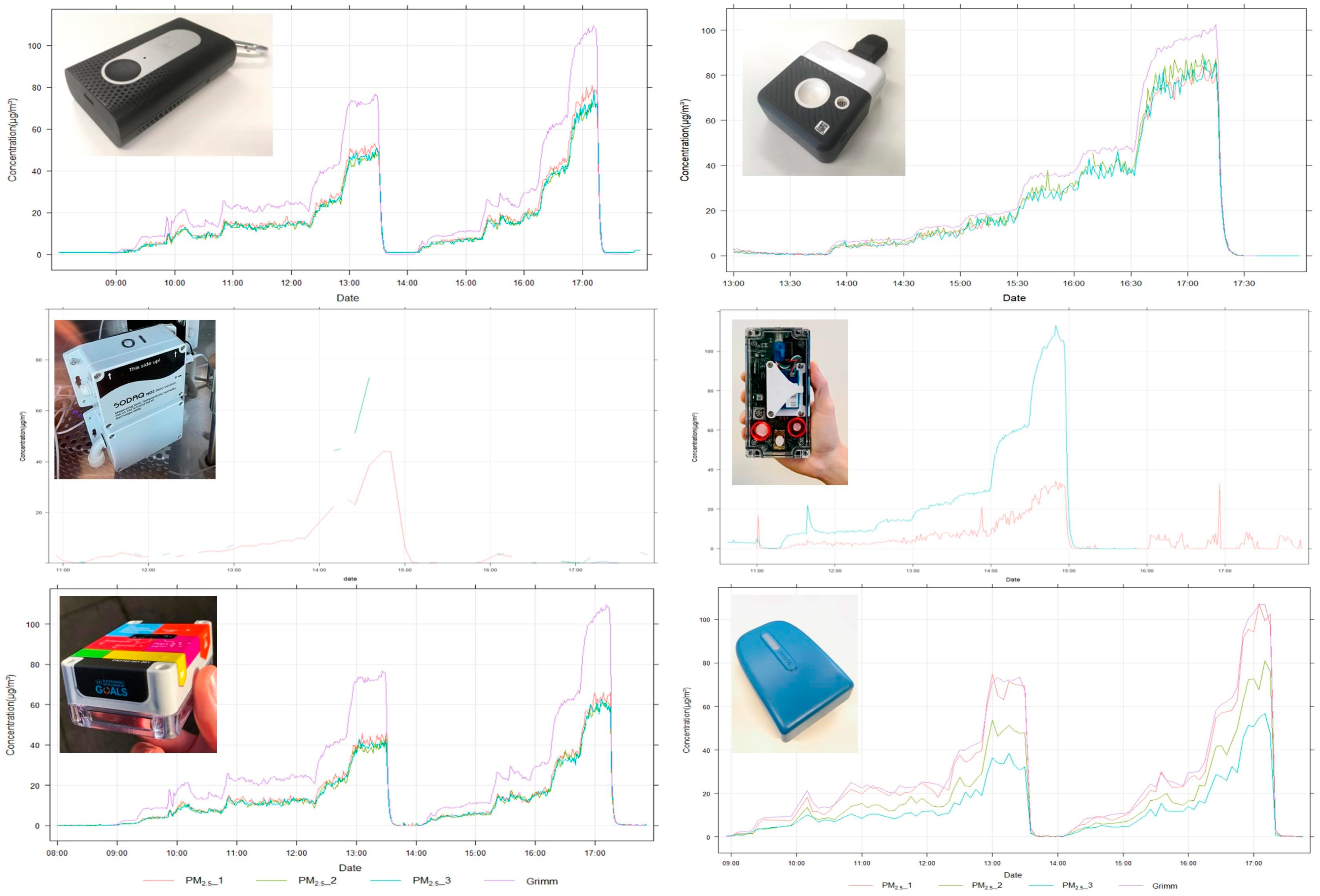
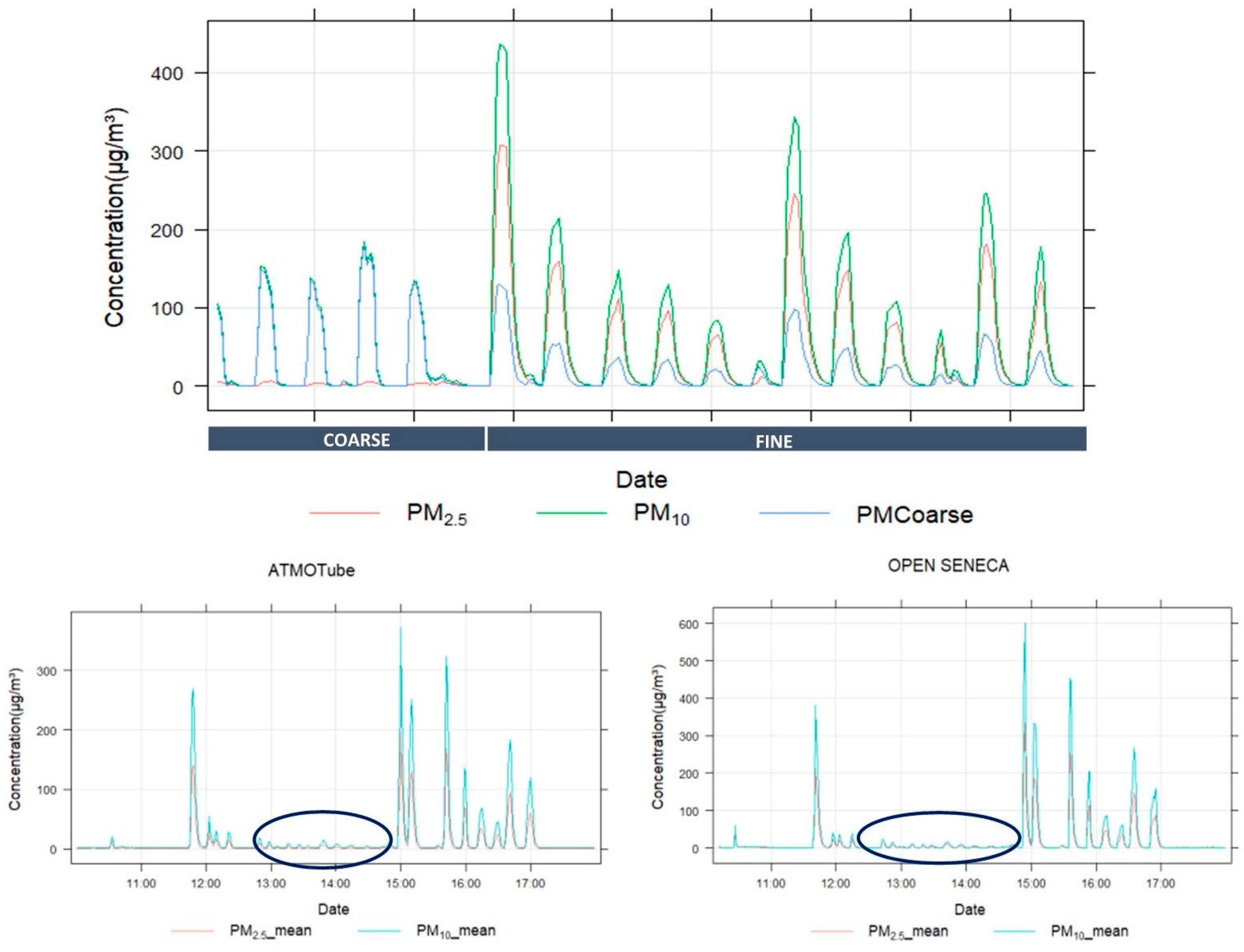
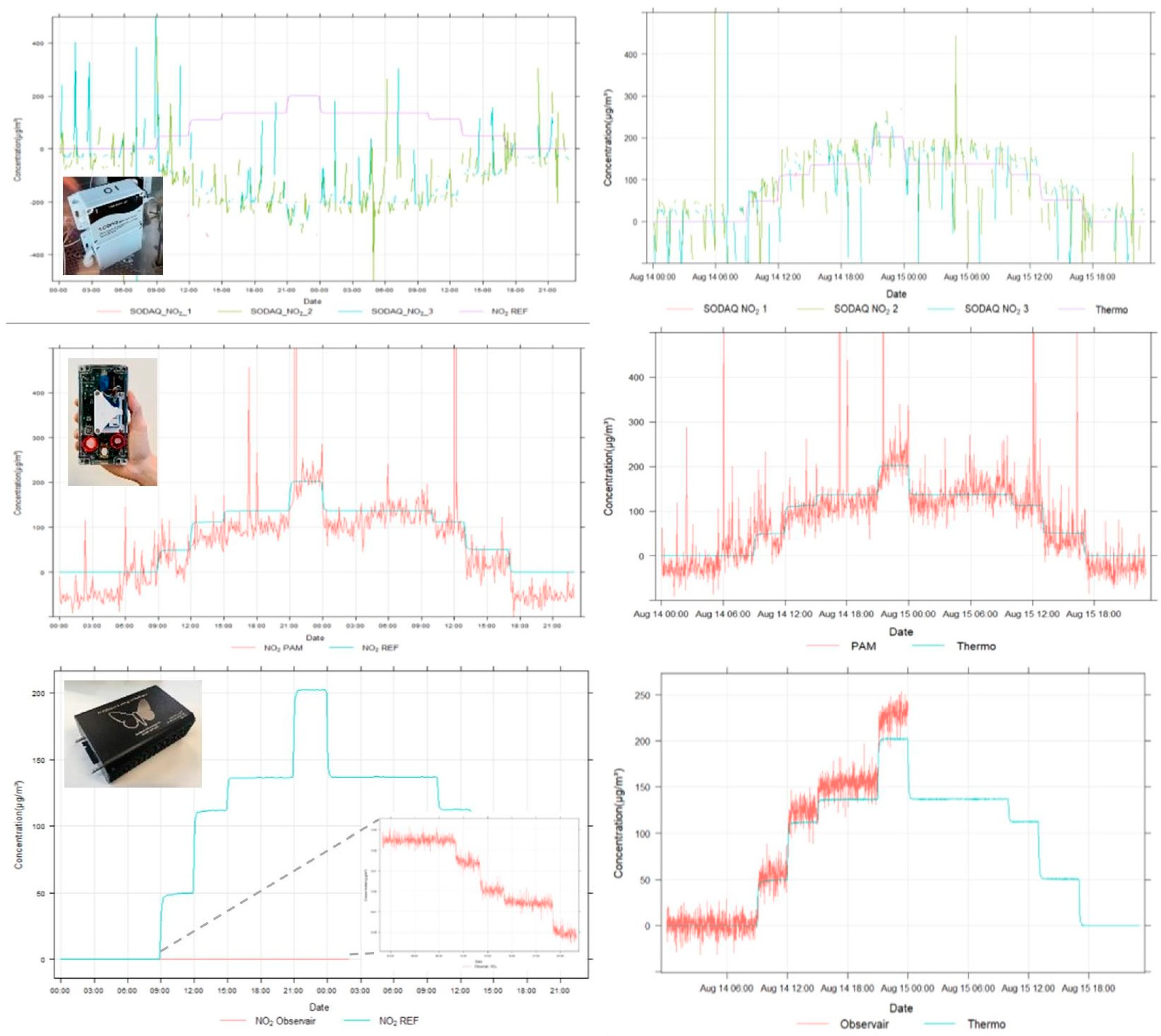
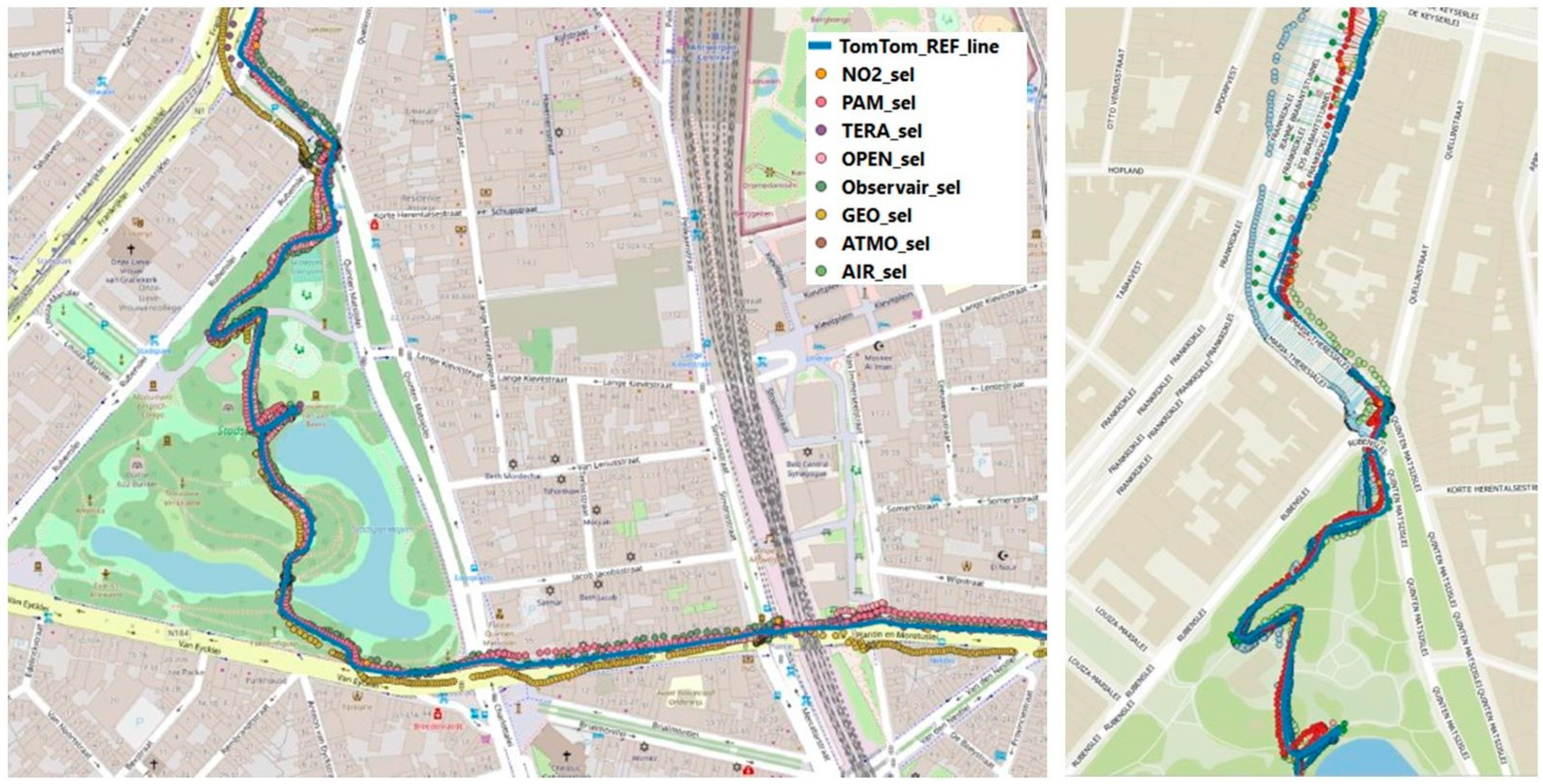
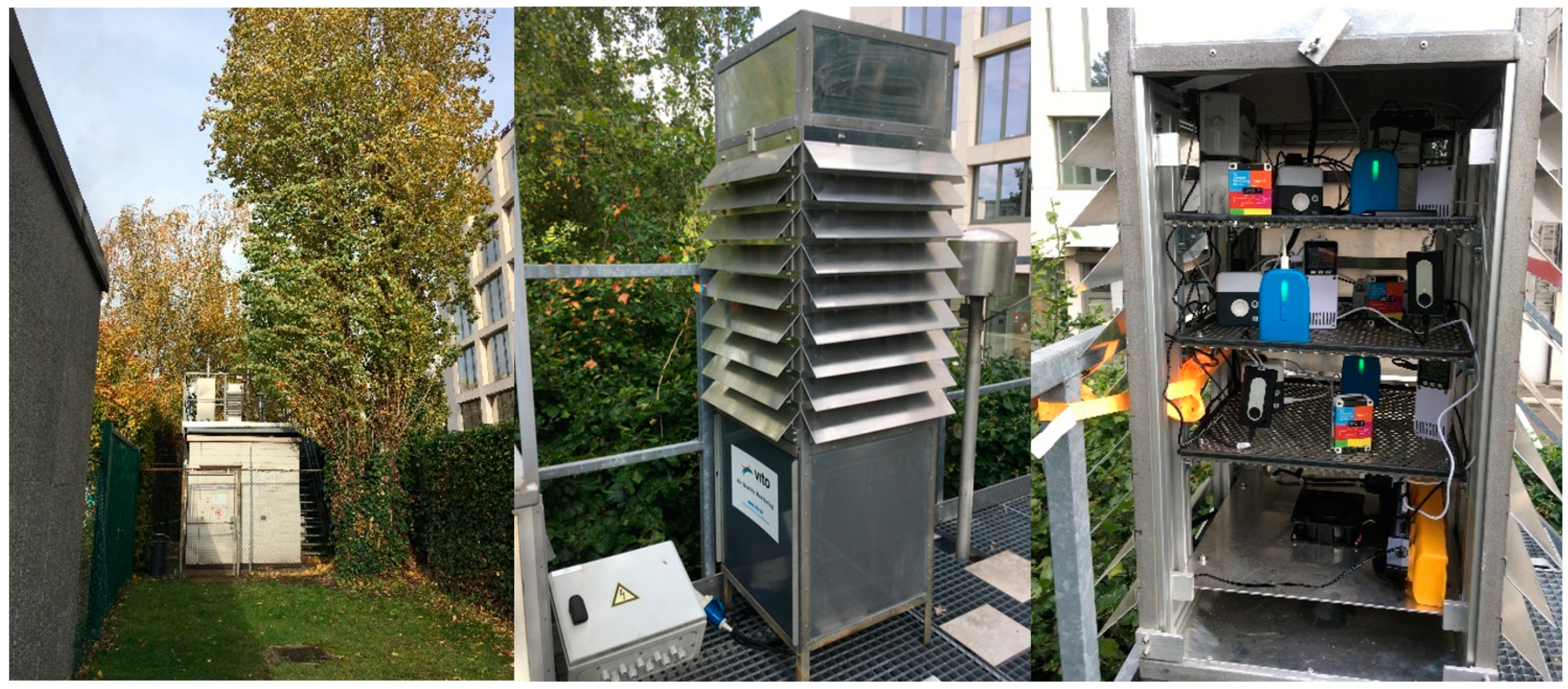

| SENSOR SYSTEM | Accuracy (%) | MAE | R2 | Uexp | BSU | |||
|---|---|---|---|---|---|---|---|---|
| PM1 | PM2.5 | PM10 | µg/m3 | - | % | µg/m3 | ||
| PM | ATMOTUBE (3) | 84 | 65 | 29 | 10.0 | 0.98 | 47 | 1.5 |
| OPEN SENECA (3) | 83 | 54 | 22 | 12.6 | 0.99 | 55 | 1.2 | |
| TERA (3) | 18 | 79 | 47 | 5.2 | 1.00 | 25 | 1.6 | |
| SODAQ Air (3) | 64 | 70 | 31 | 8.9 | 0.99 | 40 | 4.0 | |
| SODAQ NO2 (3) | 68 | 52 | 21 | 10.9 | 0.99 | 45 | NA | |
| GeoAir (3) | NA | NA | NA | NA | NA | NA | NA | |
| PAM (1) | 63 | 29 | 13 | 17.3 | 0.96 | 79 | NA | |
| SENSOR SYSTEM | Accuracy | Stability | MAE | R2 | Uexp | BSU | ||
| % | µg/m3 | µg/m3 | - | % | µg/m3 | |||
| NO2 | SODAQ NO2 (3) | −166 | 51 | 270.3 | 0.11 | 304 | 124.7 | |
| PAM (1) | 72 | 27 | 49.5 | 0.13 | 110 | NA | ||
| Observair (1) | 0 | 0 | 79.0 | 0.98 | 112 | NA | ||
| SENSOR SYSTEM | Data Coverage | MAE | R2 | Uexp | BSU | |
|---|---|---|---|---|---|---|
| % | µg/m3 | - | % | µg/m3 | ||
| PM2.5 | ATMOTUBE (3) | 76 | 4.3 | 0.88 | 48 | 0.6 |
| OPEN SENECA (3) | 100 | 3.7 | 0.90 | 35 | 0.3 | |
| TERA (3) | 17 | 4.4 | 0.87 | 64 | 0.1 | |
| SODAQ Air (3) | 44 | 3.1 | 0.68 | 16 | 0.7 | |
| SODAQ NO2 (3) | 44 | 3.8 | 0.67 | 40 | 0.4 | |
| AIRBEAM (3) | 53 | 3.9 | 0.87 | 36 | 0.7 | |
| GeoAir (3) | 96 | 3.0 | 0.89 | 28 | 0.6 | |
| PAM (1) | 100 | 4.7 | 0.89 | 66 | NA * | |
| NO2 | SODAQ NO2_raw (3) | 44 | 190.3 | 0.42 | 614 | |
| SODAQ NO2_cal (1) | 44 | 27.1 | 0.62 | 108 | ||
| SODAQ NO2_mlcal (1) | 44 | 5.6 | 0.83 | 37 | ||
| PAM (3) | 100 | 84.1 | 0.55 | 284 | ||
| PAM_cal (1) | 100 | 349.0 | 0.55 | 1225 | ||
| PAM_calml (1) | 100 | 44.2 | 0.75 | 44 | ||
| Observair_raw | 78 | 28.4 | 0.38 | 111 | ||
| Observair_cal | 78 | 28.8 | 0.38 | 95 | ||
| Observair_mlcal | 78 | NA | NA | NA | ||
| BC | Observair | 78 | 0.3 | 0.82 | ||
| BCmeter | 78 | 0.2 | 0.83 |
Disclaimer/Publisher’s Note: The statements, opinions and data contained in all publications are solely those of the individual author(s) and contributor(s) and not of MDPI and/or the editor(s). MDPI and/or the editor(s) disclaim responsibility for any injury to people or property resulting from any ideas, methods, instructions or products referred to in the content. |
© 2024 by the authors. Licensee MDPI, Basel, Switzerland. This article is an open access article distributed under the terms and conditions of the Creative Commons Attribution (CC BY) license (https://creativecommons.org/licenses/by/4.0/).
Share and Cite
Hofman, J.; Lazarov, B.; Stroobants, C.; Elst, E.; Smets, I.; Van Poppel, M. Portable Sensors for Dynamic Exposure Assessments in Urban Environments: State of the Science. Sensors 2024, 24, 5653. https://doi.org/10.3390/s24175653
Hofman J, Lazarov B, Stroobants C, Elst E, Smets I, Van Poppel M. Portable Sensors for Dynamic Exposure Assessments in Urban Environments: State of the Science. Sensors. 2024; 24(17):5653. https://doi.org/10.3390/s24175653
Chicago/Turabian StyleHofman, Jelle, Borislav Lazarov, Christophe Stroobants, Evelyne Elst, Inge Smets, and Martine Van Poppel. 2024. "Portable Sensors for Dynamic Exposure Assessments in Urban Environments: State of the Science" Sensors 24, no. 17: 5653. https://doi.org/10.3390/s24175653








